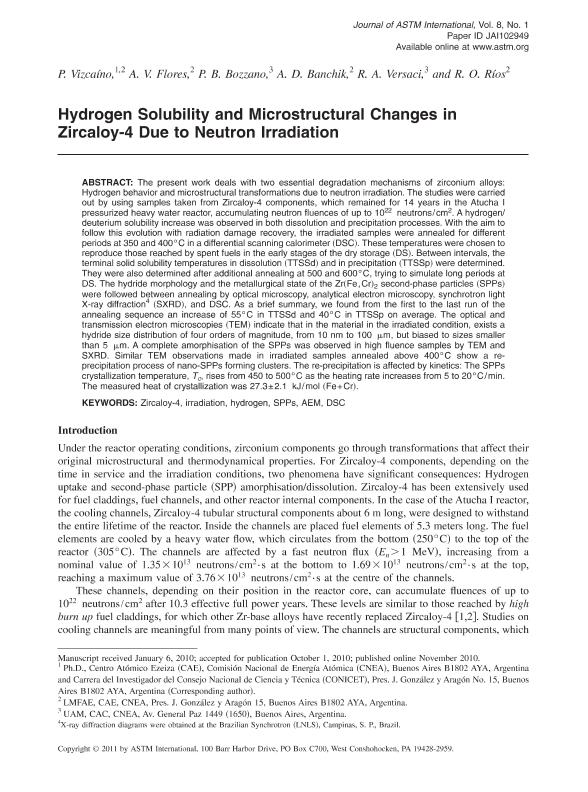Artículo
Hydrogen Solubility and Microstructural Changes in Zircaloy-4 Due to Neutron Irradiation
Vizcaino, Pablo ; Flores, A. V.; Bozzano, Patricia Beatriz; Banchik, Abraham David; Versaci, R. A.; Ríos, R. O.
; Flores, A. V.; Bozzano, Patricia Beatriz; Banchik, Abraham David; Versaci, R. A.; Ríos, R. O.
 ; Flores, A. V.; Bozzano, Patricia Beatriz; Banchik, Abraham David; Versaci, R. A.; Ríos, R. O.
; Flores, A. V.; Bozzano, Patricia Beatriz; Banchik, Abraham David; Versaci, R. A.; Ríos, R. O.
Fecha de publicación:
01/2011
Editorial:
ASTM International
Revista:
Journal of ASTM International
ISSN:
1546-962X
Idioma:
Inglés
Tipo de recurso:
Artículo publicado
Clasificación temática:
Resumen
The present work deals with two essential degradation mechanisms of zirconium alloys: Hydrogen behavior and microstructural transformations due to neutron irradiation. The studies were carried out by using samples taken from Zircaloy-4 components, which remained for 14 years in the Atucha I pressurized heavy water reactor, accumulating neutron fluences of up to 10E22 neutrons/cm2. A hydrogen/deuterium solubility increase was observed in both dissolution and precipitation processes. With the aim to follow this evolution with radiation damage recovery, the irradiated samples were annealed for different periods at 350 and 400°C in a differential scanning calorimeter (DSC). These temperatures were chosen to reproduce those reached by spent fuels in the early stages of the dry storage (DS). Between intervals, the terminal solid solubility temperatures in dissolution (TTSSd) and in precipitation (TTSSp) were determined. They were also determined after additional annealing at 500 and 600°C, trying to simulate long periods at DS. The hydride morphology and the metallurgical state of the Zr(Fe,Cr)2 second-phase particles (SPPs) were followed between annealing by optical microscopy, analytical electron microscopy, synchrotron light X-ray diffraction (SXRD), and DSC. As a brief summary, we found from the first to the last run of the annealing sequence an increase of 55°C in TTSSd and 40°C in TTSSp on average. The optical and transmission electron microscopies (TEM) indicate that in the material in the irradiated condition, exists a hydride size distribution of four orders of magnitude, from 10 nm to 100 microns, but biased to sizes smaller than 5 _m. A complete amorphisation of the SPPs was observed in high fluence samples by TEM and SXRD. Similar TEM observations made in irradiated samples annealed above 400°C show a re-precipitation process of nano-SPPs forming clusters. The re-precipitation is affected by kinetics: The SPPs crystallization temperature, Tc, rises from 450 to 500°C as the heating rate increases from 5 to 20°C/min. The measured heat of crystallization was 27.3±2.1 kJ/mol (Fe+Cr).
Palabras clave:
Zircaloy-4
,
Irradiation
,
Hydrogen
,
SPPs
,
AEM
,
DSC
Archivos asociados
Licencia
Identificadores
Colecciones
Articulos(SEDE CENTRAL)
Articulos de SEDE CENTRAL
Articulos de SEDE CENTRAL
Citación
Vizcaino, Pablo; Flores, A. V.; Bozzano, Patricia Beatriz; Banchik, Abraham David; Versaci, R. A.; et al.; Hydrogen Solubility and Microstructural Changes in Zircaloy-4 Due to Neutron Irradiation; ASTM International; Journal of ASTM International; 8; 1; 1-2011; 1-20
Compartir



